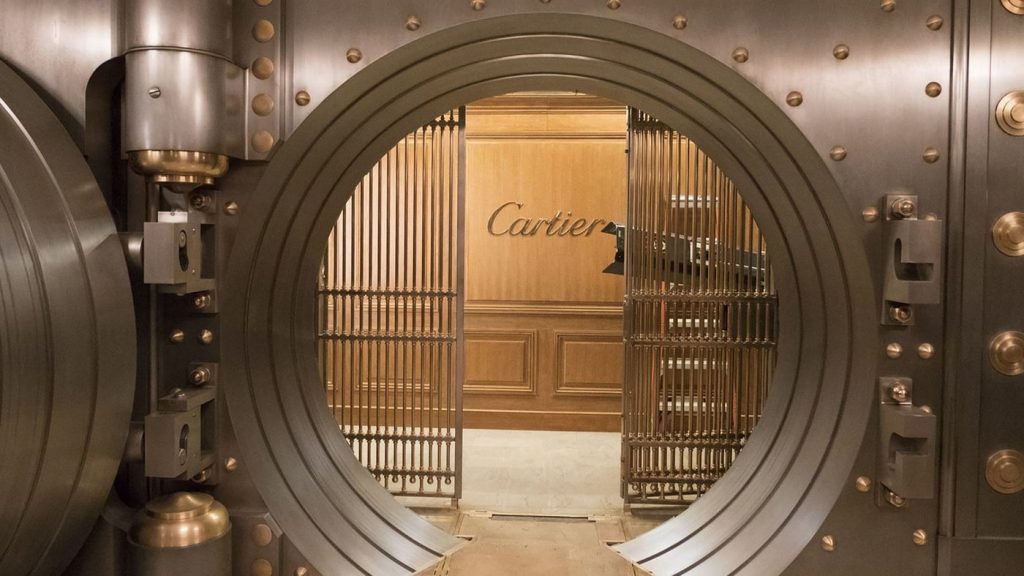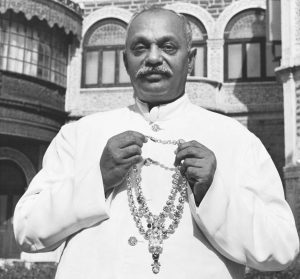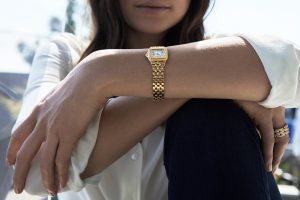connect with the hour glass
New Watch! • 09 Aug 2018
La Panthère – Toussaint’s Influence on Cartier
If you’ve been along to the cinema and seen the latest Ocean’s instalment, you’ll most definitely be familiar with the remarkably stunning – and heist-worthy – ‘Toussaint Necklace’ by Cartier. Ocean’s 8 sees a team of women trying to steal the necklace from the Met Gala, using co-host Daphne Kluger (Anne Hathaway) as an oblivious mule. The bejewelled centrepiece of the film’s plot is a labour of thoughtful design and pretty incredible craftsmanship. It took eight weeks to create in Cartier’s Paris workshop before being flown to New York for filming.

But while the high-tech heist setting for the necklace is distinctly modern, its design actually draws inspiration from the past. The necklace used in the film is a replica based on a 1931 design by Jacques Cartier, made specially for the Maharaja of Nawanagar. The original necklace was then described as “the finest cascade of coloured diamonds in the world”, and featured blue-white diamonds crowned with a colossal 136.25-carat ‘Queen of Holland’ diamond. Cartier created the 2018 version using plans, drawings and photographs from its own archive, resizing the first necklace’s man-sized proportions to fit Anne Hathaway. The replica was made with zirconium oxides mounted on white gold to mimic the original’s extreme value, but was still flawlessly crafted to withstand any close-up film shots.

The necklace’s namesake is Jeanne Toussaint, Cartier’s iconic former creative director who oversaw the maison’s accessories department at the time the necklace was commissioned. Toussaint wielded strong influence over Cartier’s designs then, but her legacy remains even now; Toussaint is frequently referred to as the Coco Chanel of jewellery, such is her everlasting impact. She is credited with popularising Cartier’s distinct animal motifs and, most notably, its signature Panthère. In fact, she earned the nickname “La Panthère” through her embodiment of everything the collection stood for: femininity, mystery, elegance, and beauty. Aside from Jeanne, perhaps the other most influential individual on Cartier in the early 20th century was the pilot Alberto Santos-Dumont.

It was in 1914 that the famous panther image first became associated with Cartier, appearing in a painting commissioned by Louis Cartier (it was only 2 years later that the first Cartier Tank came to market). The painting – Dame à la Panthère by French artist George Barbier – was intended as part of an invitation to a Parisian jewellery exhibition, but was so highly revered by Louis that it became an integral part of Cartier’s advertising. It depicted a woman, impeccably dressed, with a black panther at her feet. This set off a new chapter for Cartier, with the launch of the first piece of panther-inspired jewellery that very same year.

Like Louis, Jeanne Toussaint was a friend of George Barbier, and it’s rumoured that the painted Dame was, in fact, Toussaint herself. Quite fittingly, it’s likely that Toussaint was the first woman in Paris to wear a coat made of panther fur. Her apartment reflected her eclectic style, with panther skins strewn around as decoration. She was known for her stylish flair and ability to pull off bold prints, and was already well-respected within the Parisian fashion community. When Louis Cartier first became acquainted with her, Toussaint was designing women’s handbags. Louis wooed her into working with him and she started her journey at Cartier at the age of 31. Marking the beginning of a long and distinguished career at La Maison.

Under her skilled eye, Toussaint took Cartier to a new level. During her first few years leading the accessories department, she designed functional yet beautiful handbags for wealthy women from Europe and America. It is said that she truly understood these women and their needs, addressing them with handbags and accessories that soon became absolute necessities for women about town. Toussaint’s unparalleled ability to form deep relationships with Cartier’s clientele led Louis to appoint her as the director of fine jewellery in 1933. Here, she truly made her mark. She was hugely inspired by India and incorporated many different elements of Indian fashion into her jewellery: bold, colourful designs were infused with yellow gold and striking gemstones such as Indian coral and cabochon emeralds.

But Toussaint is best known for championing the use of animal motifs. Between the 1930s and 1950s, she worked closely with some of the era’s most glamorous and admired women, including Grace Kelly, Mona von Bismarck and Wallis Simpson Windsor. In collaboration with the Duchess of Windsor, Toussaint designed all kinds of animal motifs, from dragonflies and ladybugs, to birds of paradise and flamingos, to lions, tigers, and, of course, panthers. Throughout her time at Cartier, La Panthère surged in popularity thanks to Toussaint’s ability to translate the animal’s seductive appeal into fine jewellery pieces. Actresses including María Félix and Barbara Hutton became huge fans, as did the Duchess of Windsor, who wore the first three-dimensional panther Cartier ever produced.
One of her most famous animal-themed designs was the caged nightingale brooch. In 1941, Toussaint commissioned the design as a response to the German occupation of Paris, with the nightingale acting as a symbol of Paris’ oppression. Toussaint courageously displayed her creation in the centre of the Cartier boutique’s window display, which led to her arrest by the Gestapo. Coco Chanel, who was Toussaint’s close friend, used her connections in the Nazi regime to free Toussaint. A few years later in 1945, Toussaint revised her brooch design. The updated version showed the cage doors flung wide open and the nightingale’s wings spread wide, ready for flight, this time representing Paris’ freedom (pictured below).

Toussaint remained at the helm of Cartier’s fine jewellery department until 1970, but her legacy lived on. In 1983, Cartier launched the Panthère de Cartier collection of watches under the creative direction of Alain-Dominique Perrin. After the death of Pierre Cartier in 1964 and the ensuing sale of the business, Cartier faced somewhat of a branding crisis. With Cartier New York, Paris and London all working somewhat autonomously. The Panthère de Cartier is hugely important in that it represented one of the very first creations coming from a re-united Cartier. Impeccably finished and housing a quartz movement, the Panthère de Cartier is defined by a square dial, visible screws on the bezel and a bracelet strap that eased into the integrated lugs were taken from the unisex Santos Dumont collection. Initially, the Panthère watch was even called the ‘Santos D’ (for ‘Demoiselle’). It was later renamed to reflect the slinky articulated link bracelet that mimicked the stealthy movement of the panther as it crept through the jungle. Production of the Panthère de Cartier collection continued until the early 2000s. For a long time, watches displaying the iconic animal were only available as vintage pieces.
Everything else aside, the Panthère de Cartier was cool (it also helps when Tina Turner, Pierce Brosnan and Keith Richards take a liking to it).The Panthère de Cartier was successful in re-asserting Cartier’s luxury image whilst appealing to a larger segment of the market. Lets not forget that, until the 70’s Cartier’s creations were the purview of royalty. While other watchmakers were closing up shop, Cartier found a way to make the best of the changing watch landscape and to stay relevant.

In 2017, the maison brought its icon back with the relaunch of the Panthère de Cartier collection. The contemporary version of the classic watch still includes many of the same design features, from the quartz movement to the panther-like bracelet. This new range is extensive, coming in a variety of sizes, metals and price points. Most pieces adopt a subtle approach, simply taking on the classic shape and intricate details of the collection. Whereas the speckled La Panthère watches proudly flaunt their design inspiration. Precious metals and lacquer are used to mimic the animal’s distinctive fur pattern.



Then, there is a selection of watches that don’t shy away from their Panthère roots. Striking diamonds, jewels, yellow and white gold, and black lacquer have been combined to create spectacular designs. In these watches the panther is unabashedly front and centre. Models such as the Ronde Louis Cartier Wood And Gold Leaf Marquetry Watch, the Rencontre De Panthères Watch, the Panthère Lovée Watch and the Tortue Regard De Panthère Watch are beautiful, highly decorative and harken back to Jeanne Toussaint’s diamond set brooches.


However, the standout is easily the Cartier Révélation d’Une Panthère. If you’ve seen it (or, if you’re lucky, worn it), you’ll know just how outstanding this piece is. Cartier worked for five years to get it right, but the time spent tinkering away was well worth it. Aside from the watch’s impressive mechanics (it’s powered by a hand-wound caliber 430), the dial is really something to behold. When the watch is turned upright, 900 gold balls appear to float across the dial to reveal the face of La Panthère – a feat of engineering that Cartier has patented. The black version is widely available, but the red and green versions are limited to only 100 pieces each.

The newest Panthère de Cartier pieces are great examples of the beauty that Jeanne Toussaint cultivated during her time at Cartier. The watches in the contemporary collection pay respect to the prominent animal motifs, bright colours and embellishment she injected into her own designs and really do reflect the everlasting influence of the original Panthère.
To have a closer look at Cartier watches in the metal, do pop by one of our boutiques.
Malmaison by The Hour Glass
Knightsbridge
270 Orchard Road #01-01
Singapore 238857
The Hour Glass Sydney
142 King Street
Sydney
New South Wales 2000 Australia



